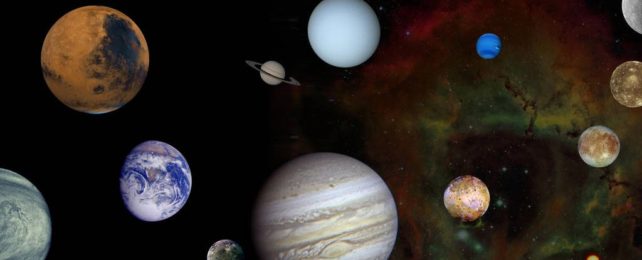As our catalog of planetary systems in the Milky Way grows, it becomes increasingly clear how very different our Solar System could have been.
In fact, of the nearly 4,000 planetary systems identified to date, none of them reflect the order and arrangement of planets orbiting our own Sun. That could be because Solar System analogs are currently outside our detection ability. But from what we can detect out there, planetary systems seem to cover an extraordinary variety of arrangements.
Now, astrophysicist Stephen Kane of the University of California, Riverside has shown that if we made just one change, the whole Solar System would go haywire.
It's not even a big change, involving the addition of one more planet of a type seen frequently in other systems.
That hypothetical planet would need to be a super-Earth or mini-Neptune, a world that sits in the mass range between Earth and Neptune, clocking in at 17 Earth masses.
Despite how common they are elsewhere in the galaxy, we don't have a super-Earth or mini-Neptune in the Solar System, creating a mass gap between the rocky terrestrial worlds and the gaseous ones.
What we do happen to have in the Solar System is a yawning great chasm between the rocky worlds and the gassy ones: a physical gap between the orbits of Mars and Jupiter, marked by an asteroid belt.
"Planetary scientists often wish there was something in between those two planets," Kane explains. "It seems like wasted real estate."
Kane wanted to know what would happen to the Solar System if he filled both gaps in one fell swoop; he created simulations in which he plopped a planet with a range of masses between Mars and Jupiter right in that space, and watched the chaos ensue.
And chaos there was indeed.
"This fictional planet gives a nudge to Jupiter that is just enough to destabilize everything else," Kane says. "Despite many astronomers having wished for this extra planet, it's a good thing we don't have it."
Depending on the mass and location of this simulated world in the space between Mars and Jupiter, the chaos can result in the current planets being ejected clean out of the Solar System. Mars's average orbit lies 1.5 astronomical units from the Sun; Jupiter's at 5.2 astronomical units. A planet placed at 3 astronomical units can exist quite peacefully, but pretty much anywhere else results in an absolute planetary omnishambles.
A planet at 3.1 to 4 astronomical units, Mercury's orbit becomes disrupted. At 2.0 to 2.7 astronomical units, Mars goes wobbly. Jupiter and Saturn only experience minor perturbations, but the angular momentum they impart to the outer Solar System worlds, Uranus and Neptune, causes the ice giants to destabilize too.
At worst, Venus, Mercury, Earth, Mars, Uranus, and Neptune all get ejected from the Solar System. Smaller changes see Earth's orbit deviate wildly from its current course, rendering our home planet less habitable, if not completely inhospitable.
Evidence already suggests that Jupiter plays a role in Earth's habitability, protecting us from asteroid bombardment. Kane's work suggests that it plays another role in stabilizing the Solar System: astronomers believe that Jupiter's gravitational influence prevents a planet from forming in the space the asteroid belt inhabits.
There's not enough material currently in the asteroid belt for a planet to form; the total mass of the belt is estimated to be just 0.04 percent of Earth's mass. Earlier in the history of the Solar System, however, the asteroid belt is thought to have been significantly weightier.
Astronomers have thought for a while now that planetary systems with a Jupiter analog are the most likely to have the stability for life. Kane's simulations add more weight to the argument.
They also suggest that the Solar System's architecture could be quite a delicate balance that is difficult to maintain.
"Our Solar System is more finely tuned than I appreciated before," Kane says. "It all works like intricate clock gears. Throw more gears into the mix and it all breaks."
There but for the grace of planetary system formation quirks go us.
The research has been published in The Planetary Science Journal.
